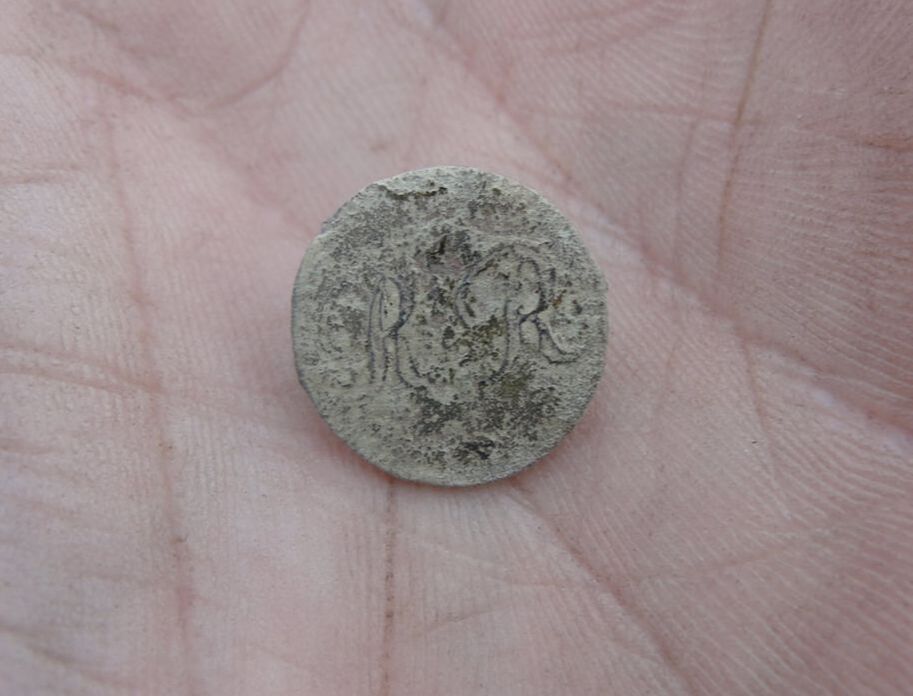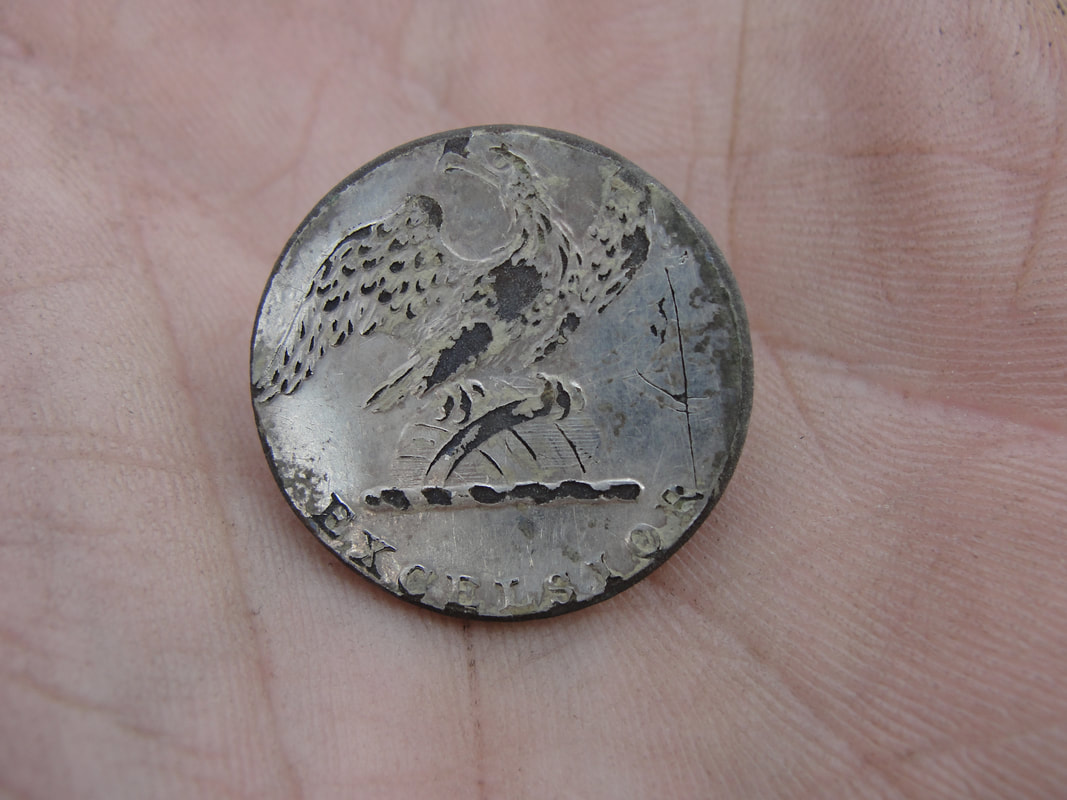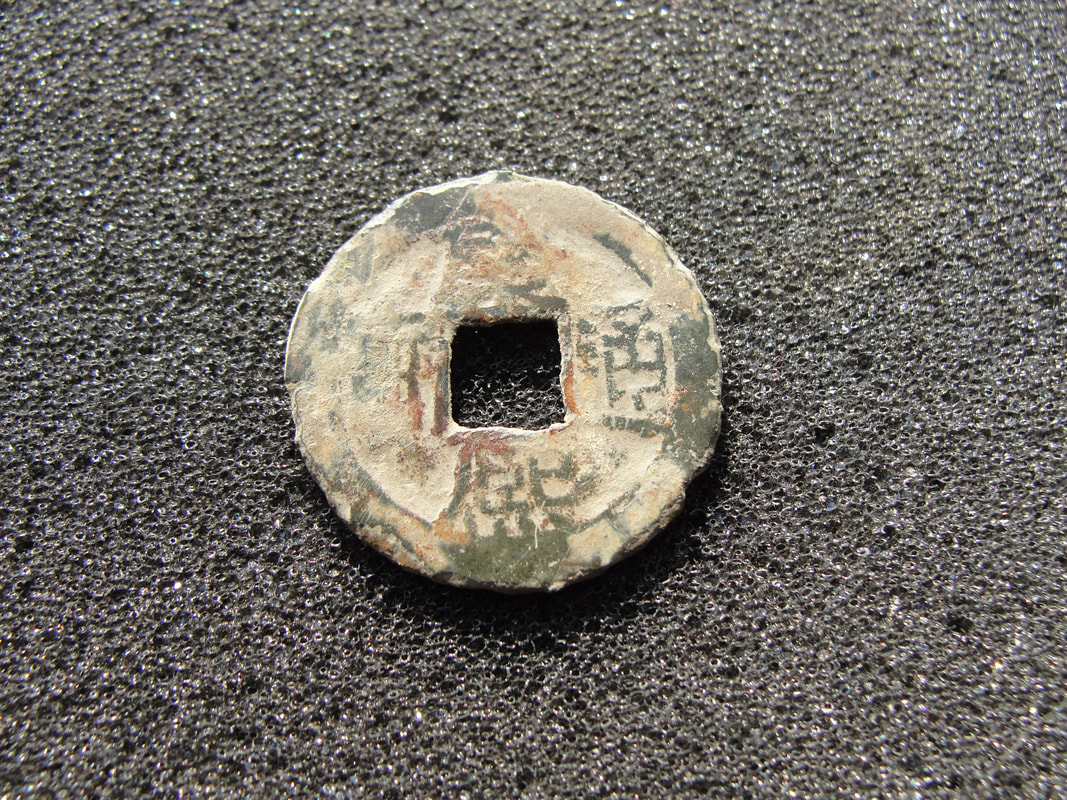|
Some of the best artifacts are found when you least expect it and despite the research I do, my most fascinating sites are often ones that I stumble upon accidentally. This particular area was originally settled in the late 17th century and I was randomly detecting through a wooded area in hopes of stumbling on a very early homestead. Nearby there is a known and fairly obvious farmhouse foundation along an old road, but it dates to the 1830's at the earliest so it wasn't a focus. There's also a foundation of an old mill next to the river and further up the abandoned road, but again it dates to the late 1820's and I was looking for earlier settlements. About halfway between the two sites and 100 meters up a hill I struck upon a mid-tone and to my surprise it wasn't another shotgun head stamp but instead a small brass flat-button. And then not 6 inches away another mid-tone produced another flat button, and then another, and then another... Fast forward 2 hours and I had recovered over 60 buttons in a small 20 foot by 30 foot area sloping down the hill and I only stopped because I was losing daylight. The next trip I recovered at least 40 more, and on the third another 35. To put this in context, the most productive home sites will sometimes turn up about 30 buttons total. My tavern site in Chatham has turned up 50-60 to date. In three trips I was well over 100 buttons of all dates, shapes, and types and I was far from done. But therein lies the mystery; why so many buttons? To add to my confusion I was recovering very little aside from buttons. At a typical homestead site you would expect to find (in addition to buttons) spoon fragments, coins, tools, buckles, kerosene lamp parts, and broken chunks of iron. After the first three trips I had found not a single coin, only one pewter spoon bowl, and confusingly dozens of broken suspenders buckles. This wasn't a homestead and obviously not a tavern or store since there would have been coins scattered about if those were the case. There were a few military buttons so an encampment was one theory, but the buttons were all from different periods and there were no dropped musket balls or bullets which encampments will nearly always have in quantity. I'll admit that I was lost on this and it wasn't until I was chatting with a few other very knowledgeable detectorists about my find when the right question was finally asked: "that nearby mill, that wasn't by chance a paper mill was it?" Paper production in the 19th century was a booming business. In the 18th century paper was made by hand, one sheet at a time ensuring that it was an expensive commodity and that the sheet size was limited to what a single individual could handle. That changed in the early 1800's when paper machines were invented that finally allowed production in quantity and of various sizes and thicknesses. Crucially, in the 18th century and the beginning of the 19th century paper was manufactured primarily out of old rags. As production of paper increased, the supply of worn out or destroyed clothing became a significant limiting factor. Eventually this lead to straw and other plant fibers being adopted as the raw material for paper, but during the early years of this paper mill it's likely that they purchased large amounts of clothing from the surrounding towns as raw material. The rags had to be carefully stripped of anything that could damage the cylinder paper machine; specifically the pulping knives and the rollers. Rag sorters were employed who went through each article of clothing to cut off buttons, buckles and go through the pockets for any foreign material before they could be cleared for the vats. In my sweeping, I had inadvertently stumbled on the hillside where the rag sorters had done their work. It explained the random assortment of buttons from all different time periods. Some buttons dated to the 1760's while the newest were early 1850's. The military buttons ranged from the War of 1812 to just prior to the Civil War and no two were of the same type. It also explained the large number of broken buckles, but complete lack of coins. The job of rag sorting wasn't a particularly good one even in those days and likely paid very little. As a result any stray coins found in the clothing were clearly pocketed by the workers as was I'm sure anything else they cared to reuse. What I found was not the entirety of the buttons produced in this way. The brass and copper from the buttons had value as material so they were probably sold for scrap. Just think that the 160+ I've found were merely the ones that they lost and I can only dream of the tens of thousands that were harvested from those clothes over the decades of operation! Still, these few survivors are incredible both for their varied designs and rich history they represent: The above four buttons are some of the nicer sporting buttons I recovered. Larger than the average button and made of stamped brass, this type of button was popular in the 1840's and often depict animals and scenes associated with fox hunts. Others may show exotic or mythological animals and in the past I've recovered examples showing camels and even a striking piece with a chimera! Buttons of this type would have been status pieces and worn to impress. Some of the best and most exciting buttons recovered were military uniform buttons. The above example is a Federal Artillery Regimental button. This style was manufactured between 1808 and 1811, but likely saw significant use during the war of 1812. Above is another War of 1812 button, but the "RR" stands for regiment of riflemen. It's only 14mm across meaning it's from the uniform cuff and the roman style font is much more uncommon that the script style and as such this is a fairly rare button to recover. This button is also a rifleman's button, but from a State militia and specifically an officer. The style dates to the 1820's and after the War of 1812 many State militias were formed to repel future attacks by the British. Highly trained, riflemen were considered elite soldiers similar to sharpshooters and worked in pairs. This put them at particular risk because the muzzle loading rifles they used were slow to reload and unlike infantry units which could set up multiple firing lines to cover soldiers who were reloading their weapons, the riflemen were instead exposed to return fire or cavalry charges. While State militias were much more common after the War of 1812, they did exist prior to that. The above button is actually very rare and was produced for New York militia use between 1800 and 1815. The eagle is sitting on a globe with the state motto "excelsior" below it. This is the highest ranking button recovered and also one of the most recent. The button itself is what's known as a 3-piece where the front and back are two separate pieces of thin, stamped brass which are held together by a third piece crimped around the edge of the other two. Quite a bit of the original gold plating remains as well. It's a Federal Officer's button and the manufacturer's mark on the back dates it to the 1850's. Buttons like this saw significant use during the Civil War, but based on the history of this site; it's likely that this was was lost prior to the war breaking out. While the military buttons were very impressive and in several cases quite rare, the best button recovered was instead a political button. This is a very rare Zachary Taylor button from the presidential campaign of 1848! The lettering around the side is "Rough & Ready" which is a shortened version of the nickname he earned during the Second Seminole War, Old Rough and Ready. During his successful presidential campaign he ran under the strength of his military service and buttons like this would have been passed out during campaign stops around the country. He was the last Whig elected as President and died in office just two years later in 1850. Campaign buttons like this were popular during the 1840s, but are seldom dug and it's likely that they were given out sparingly during the campaigns. The only other one I've found is a fragment of a Henry Clay button from 1844, so to find an intact one in such incredible shape was a real thrill! If course I found a number of relics besides the buttons. The relics above are interesting in that they represent everyday objects that would have been present in the pockets of average people between 1830-1850. While nothing is surprising, it is interesting the think about what we forget in our pockets today versus what was lost 180 years ago. Other relics are instead representative of the accessories removed from the clothing by the rag sorters. Suspenders in particular became popular in the 1840's and 1850's so naturally I recovered many examples along with the buttons. The object in the middle is actually the heel plate from a shoe and of course there were pewter spoon bowls which seem to turn up everywhere. The hillside is far from cleared of relics and each time I return I seem to find a dozen or so more buttons. While I didn't find any period US coins scattered about, I did find one coin that I wasn't expecting. It seems this oddball was discarded even by the rag sorters who I'm sure had no idea what it was. You may recognize it as a Chinese cash coin. However you're forgiven if you can't immediately recognize the specific type! It's well worn and it took some digging on my part to identify the exact variety out of the hundreds of variants out there, but finally I did.
It's a coin of Emperor Sheng Zu made between 1662 and 1722. They're sometimes known as Lohan cash coins and there are a number of legends surrounding them including that they were made from melted down statues of Buddha, or that there were certain ones made of pure gold. As a result this particular cash coin become a good luck charm and was frequently given as a gift. It may seem strange to find this in among early 19th century buttons, but this was almost certainly carried by a Chinese traveler as a good luck talisman. It's incredible to think of someone traveling so far from home in those days and facing such an unknown and different world. Maybe it was a merchant passing through or perhaps a laborer who worked in the nearby town. Even in 1850 this coin was already over 100 years old and had traveled thousands of miles. Today it's at least 300 years old and adds its own unique story to the chapters of American history told through the buttons. In my mind a fitting centerpiece for such an incredible site already overflowing with history!
1 Comment
Nicholas Kane
12/3/2023 07:37:54 pm
Would you be interested in possibly selling the two Benedict suspenders and the Stag Clasp ?
Reply
Leave a Reply. |
Author
Max Cane is an avid detectorist and historian specializing in 18th century sites, but exploring all sorts of historical structures. At both ruins and existing homesteads he recovers, preserves, and researches the artifacts that settlers lost long ago. Archives
January 2024
Categories |
|
Lost homesteads and structures are all around us and virtually every section of woodland I investigate has at least one hidden amongst the trees. I'm continually amazed by just how many there are waiting to be found and the history that they represent. If you would like to read more, I have many previous articles in my archive! Click the below link to browse through them: Article Archives |
Proudly powered by Weebly













